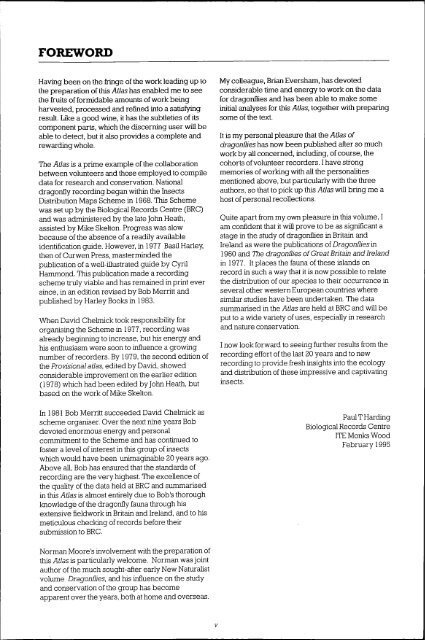Download - NERC Open Research Archive - Natural Environment ...
Download - NERC Open Research Archive - Natural Environment ...
Download - NERC Open Research Archive - Natural Environment ...
You also want an ePaper? Increase the reach of your titles
YUMPU automatically turns print PDFs into web optimized ePapers that Google loves.
FOREWORD<br />
Having been on the fringe of the work leading up to<br />
the preparation of this Atlas has enabled me to see<br />
the fruits of formidable amounts of work being<br />
harvested, processed and refined into a satisfying<br />
result. Like a good wine, it has the subtleties of its<br />
component parts, which the discerning user will be<br />
able to detect, but it also provides a complete and<br />
rewarding whole.<br />
The Atlas is a prime example of the collaboration<br />
between volunteers and those employed to compile<br />
data for research and conservation. National<br />
dragonfly recording began within the Insects<br />
Distribution Maps Scheme in 1968. This Scheme<br />
was set up by the Biological Records Centre (BRC)<br />
and was administered by the late John Heath,<br />
assisted by Mike Skelton. Progress was slow<br />
because of the absence of a readily available<br />
identification guide. However, in 1977 Basil Harley,<br />
then of Curwen Press, masterminded the<br />
publication of a well-illustrated guide by Cyril<br />
Hammond. This publication made a recording<br />
scheme truly viable and has remained in print ever<br />
since, in an edition revised by Bob Merritt and<br />
published by Harley Books in 1983.<br />
When David Chelmick took responsibility for<br />
organising the Scheme in 1977, recording was<br />
already beginning to increase, but his energy and<br />
his enthusiasm were soon to influence a growing<br />
number of recorders. By 1979, the second edition of<br />
the Provisional atlas, edited by David, showed<br />
considerable improvement on the earlier edition<br />
(1978) which had been edited by John Heath, but<br />
based on the work of Mike Skelton.<br />
In 1981 Bob Merritt succeeded David Chelmick as<br />
scheme organiser. Over the next nine years Bob<br />
devoted enormous energy and personal<br />
commitment to the Scheme and has continued to<br />
foster a level of interest in this group of insects<br />
which would have been unimaginable 20 years ago.<br />
Above all, Bob has ensured that the standards of<br />
recording are the very highest. The excellence of<br />
the quality of the data held at BRC and summarised<br />
in this Atlas is almost entirely due to Bob's thorough<br />
knowledge of the dragonfly fauna through his<br />
extensive fieldwork in Britain and Ireland, and to his<br />
meticulous checking of records before their<br />
submission to BRC.<br />
Norman Moore's involvement with the preparation of<br />
this Atlas is particularly welcome. Norman was joint<br />
author of the much sought-after early New <strong>Natural</strong>ist<br />
volume Dragonflies, and his influence on the study<br />
and conservation of the group has become<br />
apparent over the years, both at home and overseas.<br />
My colleague, Brian Eversham, has devoted<br />
considerable time and energy to work on the data<br />
for dragonflies and has been able to make some<br />
initial analyses for this Atlas, together with preparing<br />
some of the text.<br />
It is my personal pleasure that the Atlas of<br />
dragonflies has now been published after so much<br />
work by all concerned, including, of course, the<br />
cohorts of volunteer recorders. I have strong<br />
memories of working with all the personalities<br />
mentioned above, but particularly with the three<br />
authors, so that to pick up this Atlas will bring me a<br />
host of personal recollections.<br />
Quite apart from my own pleasure in this volume, I<br />
am confident that it will prove to be as significant a<br />
stage in the study of dragonflies in Britain and<br />
Ireland as were the publications of Dragonflies in<br />
1960 and The dragonflies of Great Britain and Ireland<br />
in 1977. It places the fauna of these islands on<br />
record in such a way that it is now possible to relate<br />
the distribution of our species to their occurrence in<br />
several other western European countries where<br />
similar studies have been undertaken. The data<br />
summarised in the Atlas are held at BRC and will be<br />
put to a wide variety of uses, especially in research<br />
and nature conservation.<br />
I now look forward to seeing further results from the<br />
recording effort of the last 20 years and to new<br />
recording to provide fresh insights into the ecology<br />
and distribution of these impressive and captivating<br />
insects.<br />
Paul T Harding<br />
Biological Records Centre<br />
rrEMonks Wood<br />
February 1995

















